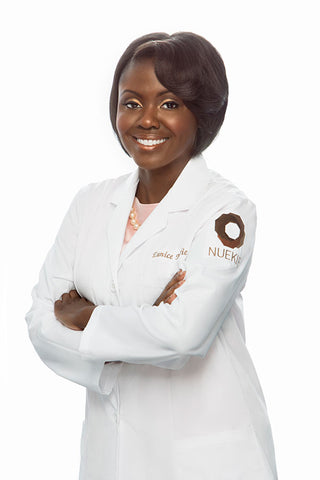
What is Acne?
Is acne a challenge that you’re battling? If so, it’s important to understand the pathogenesis of acne. In other words, what causes acne? To answer this question, let’s break down acne scientifically. There are numerous factors that determine its development and who is affected. If you’re reading this, you’ve no doubt wondered about the epidemiology of acne—why you’re dealing with it, but not the next person. Let’s discuss some facts.
There are Four Key Players that Cause Acne:
-
Follicular Hyperkeratinization—this occurs if your skin isn’t shedding dead skin cells properly, causing these cells to stick together and plug your hair follicles, which are close to pore openings.
- Propionibacterium acnes (P. acnes)—is a bacteria that naturally lives on our skin. When pores become blocked, Propionibacterium trapped inside is drawn to sebum, feeding on it. Propionibacterium then multiplies, creating a rupture in the pore, resulting in inflammation, eventually forming a pimple.
- Sebum production—can be triggered by a number of occurrences, such as: hormonal changes in puberty; menstrual shifts; androgens hormones, steroids, and endocrine disorders.
- Hormones—androgens and estrogens play a significant role in the development of acne. Androgens stimulate sebum production, whereas, fluctuating estrogen levels, during the menstrual cycle, can trigger acne.
Now that we’ve got a little scientific information under our belts, we can begin to see that acne is actually a process—a sequence of events.
Acne starts with sebum formation in the pilosebaceous apparatus, where it builds up. This creates an environment within the pilosebaceous apparatus that becomes favorable for growing the bacteria, Propionibacterium acnes, also known as p. acnes. As P. acnes increases, it causes inflammatory reactions that lead to acne lesions.
Let’s look at two other important factors that impact acne:
- Genetics—The main underlying cause of acne is due to a genetic predisposition. This means that you have a higher chance of developing acne due to the genetic makeup you inherited from a parent.
- Diet—the foods you eat could also contribute to the evolution of acne, especially if your diet is made up of foods with a high glycemic index. Some evidence suggests that blackheads might arise from a poor diet that increases insulin levels, leading to follicular hyperkeratinization—clogged pores.
We’ve discussed the facts, now let’s look at some myths.
- While diet can be a contributing factor to acne, some myths that involve food continue to persist. Chocolate and greasy foods are often said to be causes of acne, however, there is no solid evidence that these specific foods lead to acne.
- Another popular myth people cite is poor hygiene. There is a belief that individuals with acne have poor facial washing routines or do not wash enough. In fact, excessive washing can strip the skin of beneficial moisture and oils leading to acnetic skin.
- Stress is another often cited myth that is believed to cause breakouts. However, while there is no conclusive evidence, stress can produce an excess of cortisol which can lead to inflammation.
- Many people see acne as only a complexion problem, something superficial with no underlying issues, such as hormonal imbalances.
Understanding the causes of acne and the path it takes is important in tackling this condition. In our next article, we’ll discuss what acne looks like, in its many forms.

